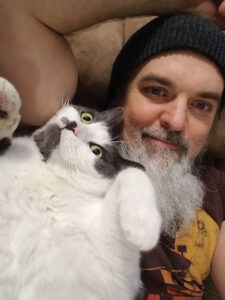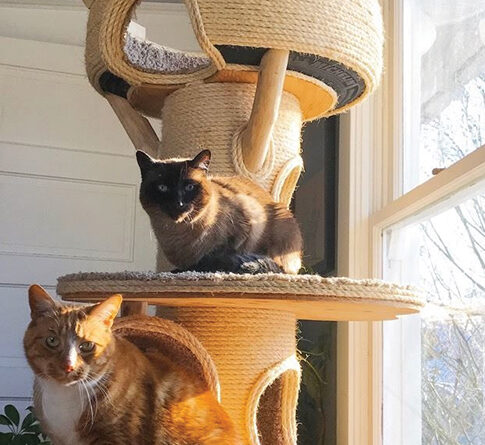Furnishings Fit for Aristocats
Christy Doherty
Mark Hircock may be the brains behind Royal Meow, but I suspect the founders were really two wee kittens who charmed him and his wife Jen. After adopting Spooky and Boo, the couple had stocked up on food, toys — and a cat tree from a big box store.
The cat tree was soon worse for the wear. Carpet, the main scratching surface, “can be a health hazard for people and pets when it gets all shredded and the particles become airborne,” Mark explains.
The couple decided to try their hand at building their own.
Using natural sisal rope, “We spent several days wrapping a large post by hand,” says Mark. Future prototypes would incorporate driftwood and car tires.
Immersed in nursing school at Clark College at that time, Mark wasn’t thinking of becoming a “cat tree guru.” But then he broke his arm and had to withdraw from school to recover. By the time he was ready to return to school, he discovered a long waitlist to get in.

With time on his hands, Mark decided to take a “cat castle” to a local pet store to gauge interest. Right away he received several orders and referrals to other shops — including one in Hawaii. The fledgling business soared.
When the pandemic diminished wholsale options, Mark. tried direct sales. Later, when wholesale again became an option, he wasn’t sure about resuming — his direct sales were strong, with customers as far away as Alaska and Texas.
“Royal Meow Cat Trees” became simply “Royal Meow,” with expanded offerings such as scratching posts, custom catios and even unique “people furniture” from reclaimed materials.
Mark is a keen observer of his own cats. They navigate and test his products, providing a feline perspective on superior design.
He’s in his glory when designing cat trees for particular spaces. “It’s a great feeling when someone trusts you to create something for their pet and they are super happy with the outcome,” he says. He also enjoys seeking out driftwood, tires and salvageable treasures to bring back to life through his designs.
“I jokingly call myself a Domestic Feline Habitat Enhancement Specialist,” he smiles. “I focus on creating the highest-quality product possible. I have customers using the same cat castles for 10 years or more, still in great condition.”
His designs incorporate “lots of curves and angles and not too many corners.” Priding himself on superior build quality, non-toxic glues and reclaimed materials when possible, Mark keeps things sustainable and environmentally responsible.
While launched to pamper two adopted kittens, Royal Meow now serves not only felines with forever homes, but also those awaiting one.
“I think I’ve donated castles to Furry Friends annual fundraisers for the past 12 years and made some for the cats living in the shelter. I’ve also worked with other groups like Cat Adoption Team and Feral Cat Coalition.”
For anyone seeking a new cat tree or catio, Mark says, “On cat trees, look for sisal on the scratching areas and solid wood or plywood construction. Stay bility in the platforms and base. Most box store cat trees are wobbly and just poorly made.
“For catios, hire someone who understands quality construction techniques and cat behavior,” he suggests. “It’s really about enhancing their experience and relieving indoor boredom while keeping them safe from traffic and other hazards. The wild bird populations are also grateful!”
“I love it when people send me pictures and tell me how happy their cats are with my products,” Mark says. “Knowing that I’ve made life a little more interesting for cats (and their humans) is really the best part.”
Learn more at royalmeow.com.

